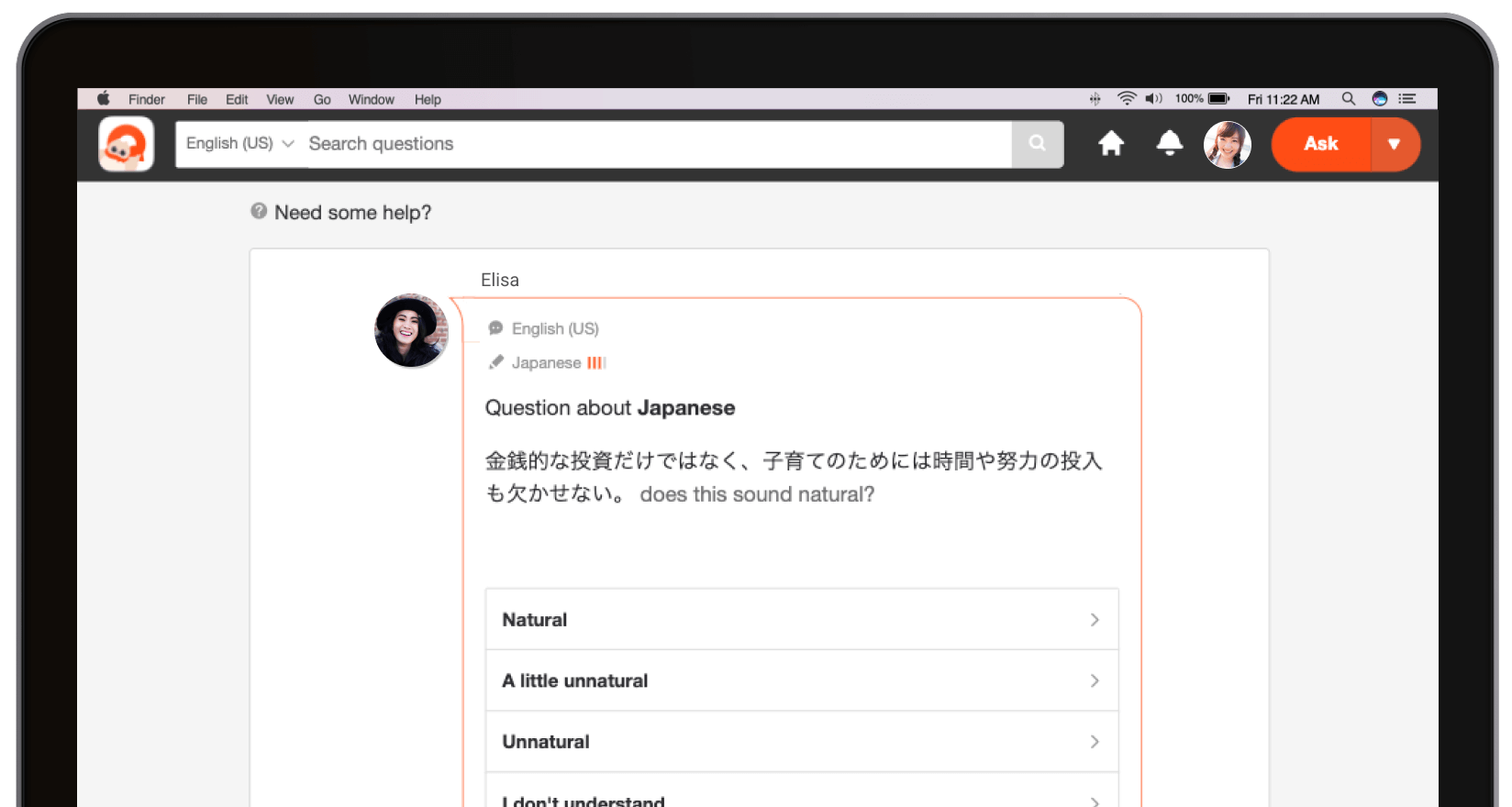Question
Zaktualizowano na
7 lip 2017
- angielski (amerykański)
-
japoński
-
koreański
-
chiński uproszczony (Chiny)
Pytanie o koreański
How is Korean grammar structured?
How is Korean grammar structured?
Odpowiedzi
Więcej komentarzy

Usunięty użytkownik
Quoted from: http://koreanheyo.blogspot.kr/2010/07/how-korea...
I'm assuming that all of you are doing fine in English and for English sentence structure we use the S-V-O rule.
S - Subject, O - Object, V - Verb, N - Noun, A - Adjective
Example: Bruce ate an apple ( Bruce is the Subject, apple is the Object, and eat is the Verb) - S-V-O
However, Korean doesn't USE the same sentence structure rule with English. Korean use the S-O-V rule.
Example: 브루스(는) 사과(를) 먹었다 = Bruce apple ate - S-O-V
Korean sentence will always end in either Noun, Verb or Adjective. So basically this is it.
I will give you more example)
리사(는) 학생이에요 = Lisa is a student (S+N)
브루스(는) 먹었어요= Bruce ate (S+V)
민디(는) 정말 예뻐요= Mindy is really pretty (S+A)
앤디(는) 물(을) 마신다= Andy drinks water, in Korean - Andy water drinks (S+O+V)
Now I think all of you notice that there is a (는) place after every subject, that is called a "Topic Marker (는,은)". There are also "Object Marker (를,을)", and many other kinds of particle which will be discussed in the future lesson.
Beside the S-O-V sentence structure, there is still another form that you might come into which all about conjugation that brings up past tense, present tense, formal and informal, spoken or written form. Sentences which ends with 다(da) is always in written form as you can see from example 4 above.
Another quoted from: http://www.linguajunkie.com/korean-2/make-korea...
Top 4 basic Korean sentence structures and word orders below:
1. S + N. Subject + Noun
나는 학생이다. - I am a student.
While this structure is marked as S+ N, there is an arguable verb in there. It’s the ending - 이다- which is often used and translated as the verb “to be,” but mostly it’s an affirmative copula (a copula is a word that links the subject of a sentence to a noun or adjective, and may or may not be a verb, but 이다 is translated as “to be.”)
To break this sentence down:
나는 - I
학생 - student
이다 - verb copula and often translated as “to be”
2. S + V. Subject + Verb
Sometimes you just want to say you’re doing an action and context isn’t necessary.“What’s Bob doing around this time- Bob sleeps.”
So, let’s look at the example below)
유나는 달린다. - Yuna runs. (Yuna- S, runs- V)
유나 - Yuna (a name)
는 - (topic marker and points to Yuna, because we’re talking about her)
달린다 - Run
3. S + A. Subject + Adjective
그는 정말 멍청해. - He is very stupid. (He-S, stupid- A)
그는 - He (notice the 는-)
정말 - very
멍청해 - stupid
Notice there is no verb ending here- Here’s a very important rule to know: Korean sentences must end with a verb (verb copula) or adjective.
Let's try another example)
유나는 정말 예쁘다 - Yuna is very beautiful. (Yuna-S beautiful-A)
예쁘다 - beautiful
4. S + O + V. Subject + Object + Verb
This is the most common pattern of all - the SOV - pattern. Remember, English is SVO, but with Korean, we usually end sentences with a verb or a verb copula. Just start thinking in the following fashion...
I water drink. I food eat. I Korean learn… and you’re good to go.
Here’s an example)
나는 물을 마신다 - I drink water. (I-S, water-O, drink-V)
Let’s break the sentence down:
나는 - I (See- 는, the topic marker is back because we’re talking about me.)
물을 - Water (을: the object particle)
마신다 - Drink
The other sentences are combinations of the above sentence using conjunction or particle.
+
Word order is not important and it doesn't matter in Korean
Czy ta odpowiedź była pomocna?
[Aktualności] Hej, Ty! Ty uczący się języka!
Wiesz jak poprawić swój język obcy❓ Potrzebujesz tylko, żeby Twoje teksty poprawił native speaker!
W HiNative native speaker poprawi Twoje teksty za darmo ✍️✨.
W HiNative native speaker poprawi Twoje teksty za darmo ✍️✨.
Zarejestruj się
Related questions
Trending questions
- só possui esses batchim duplos: ㄹㄱ-ㅂㅅ-ㄴㅈ-ㄹㄱ-ㄹㅎ- ㄴㅎ-ㄹㅌ-ㄹㅁ-ㄹㅍ-ㄹㄱ- ㄹㄱ-ㄴㅎ-ㅂㅅ-ㄹㅁ-ㄹㅂ- ㄴㅈ-ㄱㅅ?
- “감사하겠습니다”and “감사드리겠습니다” 무슨 차이가 있어요?
- 이 드라마 연출이 정말 놀랍지 않아요? my question: a- 이거 영어로 번역 좀 해 주시겠어요? (literal translation) 1- 놀라다 2- ...
- 깔끼하네 무슨 뜻이에요?
- How is this sentence I wrote ? 저희 직업은 박물관 직원입니다. 저희 박물관은 월요일에 닫습니다, 그래서 보통은 월요일에 일하는 것이 힘들지 않습니다...
Newest Questions (HOT)
- In English when speaking to someone you do not always need the pronoun “you” included in the sent...
- How do you say 'to smell' in polish? Please give me the niedokonany and dokonany form of the verb...
- Mam kilka pytań Why does the sentence “ to moja ulubiona piłka” use “to” and not “ta” ?? What...
Newest Questions
- In English when speaking to someone you do not always need the pronoun “you” included in the sent...
- Czy można powiedzieć ,, dziękuję bardzo, pan jest bardzo uprzejmy”?
- How do you say 'to smell' in polish? Please give me the niedokonany and dokonany form of the verb...
- Is there any people who lives in Krakow?
- Mam kilka pytań Why does the sentence “ to moja ulubiona piłka” use “to” and not “ta” ?? What...
Poprzednie pytanie / Następne pytanie

Dziękujemy! Zapewniamy Cię, że Twoja opinia nie będzie widoczna dla innych użytkowników.
 Dziękujemy! Twoja opinia jest dla nas bardzo cenna.
Dziękujemy! Twoja opinia jest dla nas bardzo cenna.







